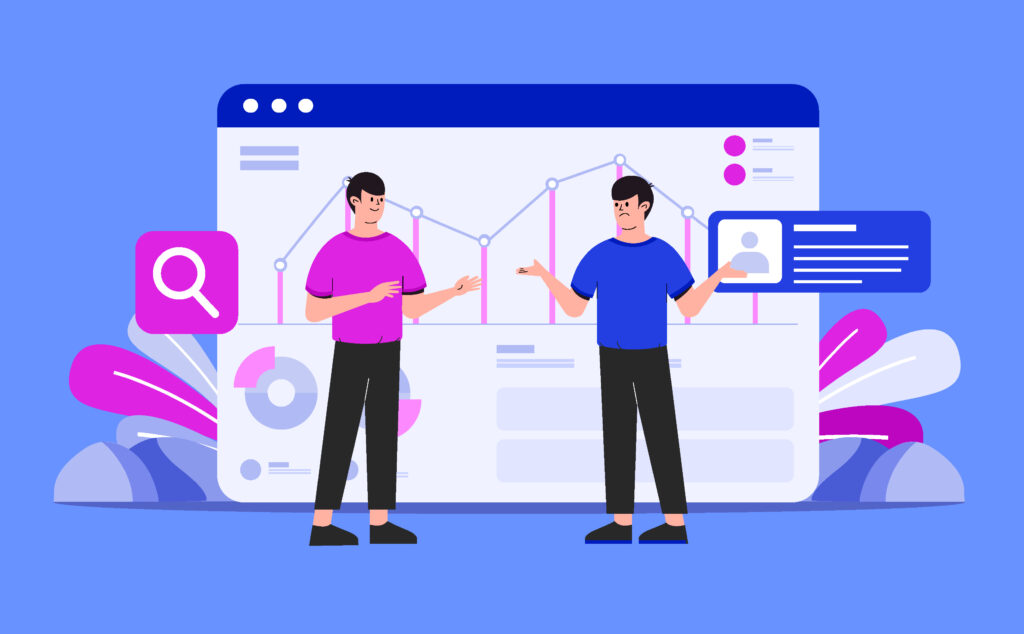Performance management is the cornerstone of any successful organization. But traditional methods, like paper reviews and periodic feedback, often fall short, leaving companies with outdated processes and frustrated employees. Today’s fast-paced business environment demands a more streamlined, data-driven approach. That’s where performance management software (PMS) comes in.
Discover how top-tier PMS software can elevate your workforce, foster a culture of continuous improvement, and align individual goals with organizational success.
What is Performance Management?
Performance Management refers to the process of planning, monitoring, and evaluating the performance of employees within an organization. It involves setting clear goals and objectives, tracking progress, providing feedback, and making necessary adjustments to improve performance.
The primary goal of Performance Management is to align employee performance with organizational goals and objectives, ensuring that employees are working towards the same strategic objectives as the company.
What are the Key Components of a Performance Management System?
A strong performance management system (PMS) is more than just annual reviews. It’s a framework for continuous feedback, goal setting, and development that empowers employees and drives organizational success. Here are the key pillars of an effective PMS:
- Performance Planning: Setting clear goals and expectations at the start of the cycle.
- Performance Monitoring: Tracking progress and providing ongoing feedback.
- Performance Development: Identifying areas for improvement and providing opportunities for growth.
- Performance Rating: Evaluating overall performance against established standards.
- Performance Rewarding: Recognizing and rewarding achievements to motivate employees.
These components work together to create a continuous and comprehensive approach to performance management.
Key Features of Performance Management System (PMS) Software
Modern performance management software goes beyond basic reviews, offering a suite of features to streamline and optimize the process:
- Goal Setting & Alignment: Set clear, measurable goals aligned with company objectives.
- Continuous Feedback: Facilitate two-way feedback loops for ongoing performance improvement.
- Performance Tracking: Monitor progress and track key metrics (KPIs) for data-driven decisions.
- Development Planning: Identify skill gaps and create personalized development plans.
- Performance Reviews & Ratings: Conduct structured reviews and provide fair, transparent evaluations.
- Recognition & Rewards: Recognize achievements and incentivize high performance.
- Reporting & Analytics: Generate insightful reports to track trends and measure program effectiveness.
- Integration: Seamlessly connect with other HR systems for streamlined data management.
These features empower organizations to create a dynamic and engaging performance management culture, driving individual and organizational success.

Benefits of Introducing Performance Management Software in Organizations
Performance management (PMS) software is a game changer that provides numerous benefits to your organization. Here are some key advantages:
-
Enhanced Goal Setting and Tracking:
- PMS software enables clear and consistent goal setting, aligning individual objectives with organizational goals.
- Employees and managers can track progress in real time, ensuring timely adjustments and feedback.
-
Improved Performance Reviews:
- Facilitates regular and structured performance reviews, moving away from traditional annual appraisals to continuous feedback.
- Provides a comprehensive view of employee performance through 360-degree feedback from peers, subordinates, and supervisors.
-
Data-Driven Decision Making:
- Generates detailed performance analytics and reports, helping management make informed decisions regarding promotions, compensation, and training needs.
- Identifies performance trends and areas requiring improvement, enabling targeted interventions.
-
Increased Employee Engagement and Motivation:
- Employees receive timely recognition and constructive feedback, boosting morale and motivation.
- Clear understanding of expectations and career progression paths enhances job satisfaction and retention.
-
Streamlined Processes and Efficiency:
- Automates administrative tasks associated with performance management, reducing paperwork and freeing up time for strategic activities.
- Ensures consistency and fairness in performance evaluations by standardizing the process.
-
Development and Training:
- Identifies skill gaps and training needs, enabling personalized development plans for employees.
- Facilitates succession planning by recognizing high-potential employees and preparing them for future roles.
-
Enhanced Communication and Collaboration:
- Promotes open communication between employees and managers, fostering a culture of transparency and trust.
- Encourages teamwork and collaboration through shared goals and collective performance tracking.
-
Compliance and Record Keeping:
- Maintains accurate and secure records of performance evaluations, supporting compliance with labor laws and regulations.
- Provides an auditable trail of performance-related decisions and actions, reducing legal risks.
-
Customization and Scalability:
- Offers flexibility to tailor the system to the specific needs and goals of the organization.
- Scales with organizational growth, accommodating changes in structure, size, and processes.
-
Cost-Effectiveness:
- Reduces costs associated with manual performance management processes, including administrative overhead and errors.
- Enhances ROI by improving employee productivity and organizational outcomes.
What Analytics and Reporting Capabilities do PMS Software Offer?
Performance Management Software (PMS) platforms offer powerful analytics and reporting capabilities to track, analyze, and enhance employee and organizational performance. Key features include:
- Real-Time Data Analysis for prompt issue identification and opportunities.
- Predictive and Prescriptive Analytics using historical data for informed decision-making.
- Customizable Reports focusing on specific metrics for strategic insights.
- Integration and Data Visualization for navigating complex performance data.
- Self-Service Discovery and Ad-Hoc Analysis for customized reporting.
- Real-Time Access to Key Performance Indicators (KPIs) for data-driven operations.
- Cross-Platform Analytics for optimizing user experience across multiple channels.
Integrating Performance Management (PMS) Software with Other HR Systems
Modern PMS platforms seamlessly integrate with other HR systems, creating a centralised hub for employee information and streamlining key processes:
- Integration with Human Resource Information System (HRIS): Integrating PMS with HRIS synchronizes employee data, reducing redundancy and errors. It ensures seamless access to employee information during evaluations and goal-setting.
- Integration with Talent Management System: Integrating PMS with talent management systems aligns employee performance with development initiatives, informing training, career progression, and succession planning.
- Integration with Compensation and Benefits Management: Linking PMS with compensation systems connects performance to rewards. It uses performance data to guide salary adjustments, bonuses, and incentives, ensuring recognition for high performers.
- Integration with Analytics and Reporting Tools: PMS integration with analytics tools generates comprehensive reports and dashboards, offering insights for data-driven decision-making and strategic planning.
- Integration with Collaboration and Communication Tools: Connecting PMS with collaboration tools enhances communication and feedback between managers, employees, and HR, streamlining real-time feedback, goal tracking, and continuous performance discussions.
Effective integration of PMS with other HR systems not only enhances operational efficiency but also contributes to better employee engagement, talent retention, and organizational performance.

Choosing the Right Performance Management System (PMS) Software for Your Business
Choosing the right Performance Management System (PMS) software for your business involves several key considerations. Here is a simplified approach to ensure you select the most effective and best PMS software for your organization:
-
Align with Business Goals
- Understand Your Company’s Objectives: Identify your company’s long-term goals and how the PMS software will help you achieve them.
- SMART Goals: Ensure the software aligns with Specific, Measurable, Achievable, Realistic, and Timely goals.
-
Ease of Use
- User-Friendliness: Choose software that is easy to use for all levels of staff, eliminating the need for extensive training.
- Customization: Opt for a customizable system that can adapt to your organization’s unique needs.
-
Integration and Automation
- Cloud-Based: Select a cloud-based system for greater flexibility, scalability, and security.
- Automated Tasks: Look for software that automates routine HR tasks, freeing up resources for more strategic activities.
-
Feedback and Development
- Real-Time Feedback: Ensure the software provides real-time feedback and continuous performance conversations.
- Training and Development: Include training modules that align with your organization’s needs and encourage employee growth.
-
Reporting and Analytics
- Real-Time Reporting: Choose software that offers real-time reporting to track employee performance and identify areas for improvement.
- Data Insights: Opt for a system that provides valuable data insights to inform strategic decisions.
-
Cost-Effectiveness
- Cost-Effective: Select a system that is cost-effective and scalable to accommodate your organization’s growth.
-
Vendor Support
- Seamless Deployment: Ensure the vendor provides seamless deployment, onboarding training, and after-sales support.
-
Flexibility and Scalability
- Flexibility: Choose software that allows you to tailor it to your specific needs and adapt to changes in your organization.
- Scalability: Opt for a system that can grow with your organization, handling increased headcount and changing needs.
-
Employee Engagement
- Employee Engagement: Select a system that fosters employee engagement and recognition, leading to higher productivity and retention.
-
Future-Proofing
- Future-Proof: Choose a system that is future-proof, incorporating AI and automation to stay ahead of the curve.
By considering these factors, you can ensure that your PMS software aligns with your business goals, is user-friendly, and provides the necessary tools for employee growth and development.
The Best Performance Management System (PMS) Software of 2024
Here’s a list of the 10 most renowned PMS software, along with their key features, pros, and cons:
-
BambooHR
- BambooHR is a comprehensive HR management solution that includes a robust performance management module.
- Key Features: Goal tracking, real-time feedback, customizable review cycles, employee development plans, and advanced reporting.
- Pros: User-friendly interface, seamless integration with other HR functions, and excellent customer support.
- Cons: Pricing may be higher for smaller businesses, limited customization options for review templates.
-
PerformYard
- PerformYard is a dedicated performance management platform designed to streamline employee evaluation processes.
- Key Features: Continuous feedback loops, 360-degree reviews, goal alignment, competency mapping, and advanced analytics.
- Pros: Highly customizable, powerful reporting capabilities, and intuitive interface.
- Cons: Limited integration options with other HR systems, steeper learning curve for administrators.
-
Lattice
- Lattice is a modern performance management solution that emphasizes continuous feedback and employee engagement.
- Key Features: Real-time feedback, goal tracking, pulse surveys, 1-on-1 meeting agendas, and employee recognition.
- Pros: Engaging user experience, seamless mobile access, and strong focus on employee development.
- Cons: Limited customization options for review forms, fewer advanced reporting features.
-
Reflektive
- Reflektive is a powerful performance management platform that encourages frequent feedback and goal alignment.
- Key Features: Real-time feedback, goal tracking, 360-degree reviews, competency assessments, and interactive dashboards.
- Pros: Intuitive interface, robust reporting capabilities, and strong integrations with other HR systems.
- Cons: Higher pricing for smaller organizations, limited customization options for review forms.
-
PerformanceHub
- PerformanceHub is a cloud-based performance management solution that simplifies employee evaluation processes.
- Key Features: Customizable review forms, goal tracking, 360-degree feedback, competency management, and advanced reporting.
- Pros: Highly configurable, robust integrations with other HR systems, and strong customer support.
- Cons: User interface may feel outdated for some users, limited mobile functionality.
-
ClearCompany
- ClearCompany offers a comprehensive talent management suite that includes a robust performance management module.
- Key Features: Goal tracking, real-time feedback, customizable review cycles, succession planning, and talent calibration.
- Pros: Seamless integration with other talent management functions, strong reporting capabilities, and excellent scalability.
- Cons: Steeper learning curve for administrators, limited customization options for review templates.
-
Peoplebox
- Peoplebox is a modern, cloud-based performance management system that emphasizes continuous feedback, goal alignment, and employee development.
- Key Features: Real-time feedback, goal tracking, 360-degree reviews, customizable review cycles, employee development plans, analytics, and reporting.
- Pros: User-friendly interface, strong focus on continuous feedback and growth, configurable, robust mobile functionality.
- Cons: Limited advanced reporting compared to enterprise solutions, pricing may be higher for larger organizations.
-
Engagedly
- Engagedly is a comprehensive performance management solution that focuses on employee engagement and continuous feedback.
- Key Features: Real-time feedback, goal tracking, pulse surveys, 1-on-1 meeting agendas, and employee recognition.
- Pros: Engaging user experience, strong focus on employee development, and robust mobile functionality.
- Cons: Limited customization options for review forms, fewer advanced reporting features.
-
ReviewSnap
- ReviewSnap is a user-friendly performance management platform that simplifies employee evaluation processes.
- Key Features: Customizable review forms, 360-degree feedback, goal tracking, competency assessments, and interactive dashboards.
- Pros: Intuitive interface, robust reporting capabilities, and strong integration options.
- Cons: Limited mobile functionality, fewer advanced features for larger organizations.
-
Trakstar
- Trakstar is a comprehensive performance management solution that offers advanced features for goal alignment and talent development.
- Key Features: Goal tracking, real-time feedback, customizable review cycles, succession planning, and advanced analytics.
- Pros: Powerful reporting and analytics capabilities, strong focus on employee development, and excellent scalability.
- Cons: Higher pricing for smaller organizations, steeper learning curve for administrators.
Please note that these software solutions and their features are subject to change, and it’s always recommended to thoroughly research and evaluate each option based on your specific organizational needs and requirements.

Need Professional Advice on Purchasing the Best PMS Software?
Choosing the right Performance Management System (PMS) software can be a complex and daunting task. With so many options available, it’s crucial to make an informed decision that aligns with your specific needs and budget.
Introducing StaQ.ai and StaQ.Co-Pilot:
- StaQ.ai is your one-stop shop for all your SaaS needs. We offer a vast marketplace of vetted and trusted PMS software solutions, making it easy to compare and choose the right fit for your organization.
- StaQ.Co-Pilot acts as your personal navigator through the software buying process. Our team of experienced advisors provides personalized recommendations and insights to help you make informed decisions.
Whether you’re a startup or a large enterprise, our marketplace offers a range of options to suit your unique requirements. Discover how much you should invest in top-tier Performance Management Software and achieve optimal performance and growth.




